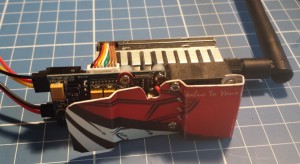The test flight ended in disaster.. it started well enough.. had positive control for about 5 minutes, one thing I noticed with a low kv motor is the slow control response which I think I can get used too anyway. Disaster struck when one of the props shattered mid flight.. I suspect I over screwed the plastic prop and it probably had a crack. The quad fell like a rock from approx 20ft. and landed on its back. 3 of 4 of the motormounts broke off..the motors adapters were damaged though the gps, apm and escs seems to be ok.
Important lesson here is: use CF props on the get go AND if possible use the appropriate prop adapter! yes even prop adapters have CW and CCW shaft threads!
Heres the scene of the disaster..landed where it can do the most damage…on the cement runway =(
and the video:























